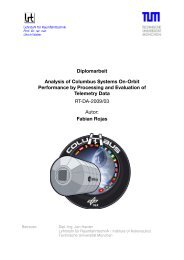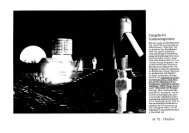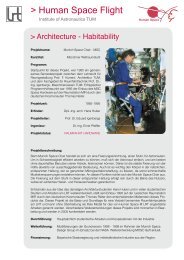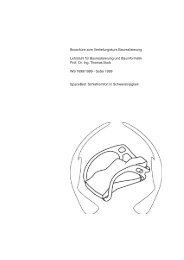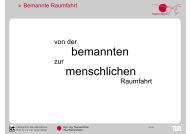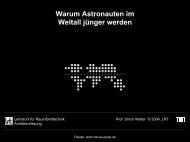Microarchitecture Space Studies Report - Technische Universität ...
Microarchitecture Space Studies Report - Technische Universität ...
Microarchitecture Space Studies Report - Technische Universität ...
You also want an ePaper? Increase the reach of your titles
YUMPU automatically turns print PDFs into web optimized ePapers that Google loves.
<strong>Technische</strong> <strong>Universität</strong> München<br />
<strong>Microarchitecture</strong> <strong>Space</strong> <strong>Studies</strong><br />
Project:<br />
D. BOCS<br />
Results<br />
The results of the testing were extremely good and very pleasing.<br />
© 1999 all copyrights of the shown projects are with the designers<br />
and the departement for design and architecture at tu münchen<br />
Summary <strong>Report</strong><br />
Date: 12/06/1999<br />
Page: D 03<br />
Opening mechanism of the doors:<br />
The press mechanism to open the doors was a lot easier than expected. It was even possible to open the<br />
doors without any kind of restraint, because the necessary force was very small and one could hold onto<br />
the door itself. Easiest of all was using foot loops (loose rope or bar). Using handrails was quite difficult, but<br />
this was presumably due to the inexperienced test person.<br />
Generally the press mechanisms was a great success.<br />
Fixation of the doors<br />
The spring hinge specially developed to hold open the doors at 180° did not only work perfectly, but also<br />
had the big advantage that it opened the doors automatically in zero-g. many test persons agreed that this<br />
was a great feature of the system.<br />
Each of the three opening BOCSes had a different number of spring hinges (one, two and three)<br />
Other than expected the BOCS with three spring hinges worked best of all. It seems to be better to have a<br />
door that opens quickly and to have a more powerful fixation of the door (180°). Even during disturbances of<br />
the parabolas the door stayed fixed in the opened position.<br />
Crew quarter design<br />
The arrangement of seven BOCSes on top of each other is fine. It is easier to reach the top and middle units<br />
but also possible to reach the lowest unit without any problems. Reaching units should not be a problem in<br />
zero-g anyway, because an astronaut can float and turn as he or she pleases.<br />
I found out that it was very easy to simply turn upside down and use the BOCSes the other way around.<br />
The opening radius of the doors was no problem at all. In every position the opening of the doors should<br />
not bother the astronaut in any way.<br />
Using a BOCS (interior)<br />
The system of adjustable bars to change the size of the bungies was extremely useful. It was possible to fix<br />
any kind and any number of items in a BOCS. A great advantage is the adjustability of the bungies., because<br />
the use of a BOCS can be changed any time and it will work for any kind of stowage.<br />
The only thing that needs improving is the adjustable bar itself. A better grip is necessary to loosen and<br />
tighten the small winding. The mechanism otherwise is fine.<br />
Fixing items to the door with velcro was also approved - the items did not get loose when the door was<br />
opened.<br />
The idea to have a small volume but a large surface for fixing all the different items (door and back side) was<br />
very successful, because a lot of items could be stored in one BOCS and still easily found and reached.<br />
Handling BOCSes<br />
The small size of a unit was very handy and useful. It was possible to take out a BOCS and carry it about in<br />
zero-g (more units were also no problem). This could be useful for storing tools or other equipment,




